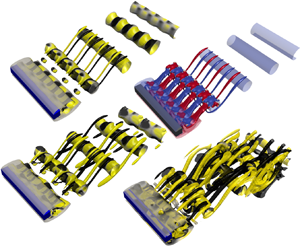Article contents
Square cylinder in the interface of two different velocity streams
Published online by Cambridge University Press: 24 October 2022
Abstract

We investigate the incompressible flow past a square cylinder immersed in the wake of an upstream nearby splitter plate separating two streams of different velocity. The bottom stream Reynolds number, based on the square side,  $Re_B=56$ is kept constant while the top-to-bottom Reynolds numbers ratio
$Re_B=56$ is kept constant while the top-to-bottom Reynolds numbers ratio  $R\equiv Re_T/Re_B$ is increased in the range
$R\equiv Re_T/Re_B$ is increased in the range  $R\in [1,6.5]$, corresponding to a coupled variation of the bulk Reynolds number
$R\in [1,6.5]$, corresponding to a coupled variation of the bulk Reynolds number  $Re\equiv (Re_T+Re_B)/2\in [56,210]$ and an equivalent non-dimensional shear parameter
$Re\equiv (Re_T+Re_B)/2\in [56,210]$ and an equivalent non-dimensional shear parameter  $K\equiv 2(R-1)/(R+1)\in [0,1.4667]$. The onset of vortex shedding is pushed to higher
$K\equiv 2(R-1)/(R+1)\in [0,1.4667]$. The onset of vortex shedding is pushed to higher  $Re$ as compared with the square cylinder in the classic configuration. The advent of three dimensionality is triggered by a mode-C-type instability, much as reported for open circular rings and square cylinders placed at an incidence. The domain of minimal spanwise-periodic extension that is capable of sustaining spatiotemporally chaotic dynamics, namely one accommodating about twice the wavelength of the dominant eigenmode, has been chosen for the analysis of the wake transition regime. The path towards spatiotemporal chaos is, in this minimal domain, initiated with a modulational period-doubling tertiary bifurcation that also doubles the spanwise periodicity. At slightly higher values of
$Re$ as compared with the square cylinder in the classic configuration. The advent of three dimensionality is triggered by a mode-C-type instability, much as reported for open circular rings and square cylinders placed at an incidence. The domain of minimal spanwise-periodic extension that is capable of sustaining spatiotemporally chaotic dynamics, namely one accommodating about twice the wavelength of the dominant eigenmode, has been chosen for the analysis of the wake transition regime. The path towards spatiotemporal chaos is, in this minimal domain, initiated with a modulational period-doubling tertiary bifurcation that also doubles the spanwise periodicity. At slightly higher values of  $R$, the flow has become spatiotemporally chaotic, but the main features of mode C are still clearly distinguishable. Although some of the nonlinear solutions found along the wake transition regime employing the minimal domain might indeed be unstable to long wavelength disturbances, they still are solutions of the infinite cylinder problem and are apt to play a relevant role in the inception of spatiotemporally chaotic dynamics.
$R$, the flow has become spatiotemporally chaotic, but the main features of mode C are still clearly distinguishable. Although some of the nonlinear solutions found along the wake transition regime employing the minimal domain might indeed be unstable to long wavelength disturbances, they still are solutions of the infinite cylinder problem and are apt to play a relevant role in the inception of spatiotemporally chaotic dynamics.
JFM classification
Information
- Type
- JFM Papers
- Information
- Copyright
- © The Author(s), 2022. Published by Cambridge University Press
References
REFERENCES
- 6
- Cited by


